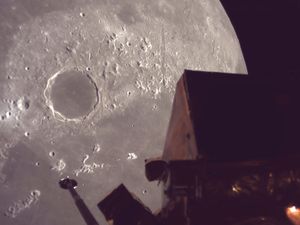Private Japanese lunar lander heads towards touchdown in the Moon’s far north
Resilience holds a rover with a shovel to gather lunar dirt.

A private lunar lander from Japan is closing in on the Moon, aiming for a touchdown in the unexplored far north with a mini rover.
The Moon landing attempt by Tokyo-based company ispace on Friday Japan time is the latest entry in the rapidly expanding commercial lunar rush.
The encore comes two years after the company’s first moonshot ended in a crash landing, giving rise to the name Resilience for its successor lander.
Resilience holds a rover with a shovel to gather lunar dirt as well as a Swedish artist’s toy-size red house that will be lowered onto the Moon’s dusty surface.
Long the province of governments, the Moon became a target of private outfits in 2019, with more flops than wins along the way.
Launched in January from Florida on a long, roundabout journey, Resilience entered lunar orbit last month.
It shared a SpaceX ride with Firefly Aerospace’s Blue Ghost, which reached the Moon faster and became the first private entity to successfully land there in March.
Another US company, Intuitive Machines, arrived at the Moon a few days after Firefly. But the tall, spindly lander face-planted in a crater near the Moon’s south pole and was declared dead within hours.
Resilience is targeting the top of the Moon, a less forbidding place than the shadowy bottom.
The ispace team chose a flat area with few boulders in Mare Frigoris or Sea of Cold, a long and narrow region full of craters and ancient lava flows that stretches across the near side’s northern tier.
Once settled with power and communication flowing, the 7.5-foot Resilience will beam back pictures, expected several hours or more after touchdown.
It will be at least the weekend, according to ispace, before the lander lowers the piggybacking rover onto the lunar surface.
Made of carbon fibre-reinforced plastic with four wheels, ispace’s European-built rover — named Tenacious — sports a high-definition camera to scout out the area and a shovel to scoop up some lunar dirt for Nasa.
The rover, weighing just five kilograms, will stick close to the lander, going in circles at a speed of less than one inch per second.
It is capable of venturing up to two-thirds of a mile from the lander and should be operational throughout the two-week mission, the period of daylight.
Besides science and tech experiments, there is an artistic touch.
The rover holds a tiny, Swedish-style red cottage with white trim and a green door, dubbed the Moonhouse by creator Mikael Genberg, for placement on the lunar surface.
Takeshi Hakamada, CEO and founder of ispace, considers the latest moonshot “merely a stepping stone”, with its next, much bigger lander launching by 2027 with Nasa involvement, and even more to follow.
“We’re not trying to corner the market. We’re trying to build the market,” Jeremy Fix, chief engineer for ispace’s US subsidiary, said at a conference last month. “It’s a huge market, a huge potential.”
Mr Fix noted that ispace, like other businesses, does not have “infinite funds” and cannot afford repeated failures. While not divulging the cost of the current mission, company officials said it is less than the first one which exceeded 100 million dollars.





